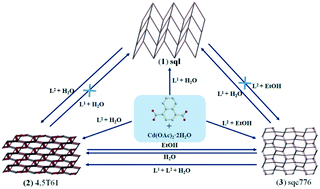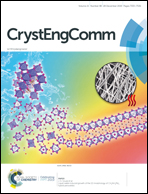Crystal-to-crystal transformation and linker exchange in Cd(ii) coordination polymers based on flexible bis-pyridyl-bis-amide and 1,4-naphthalenedicarboxylate†
Abstract
Solvothermal reactions of Cd(II) salts and naphthalene-1,4-dicarboxylic acid (1,4-H2NDC) with bis(N-pyrid-3-ylmethyl)adipoamide, L1, and bis(N-pyrid-3-ylmethyl)suberoamide, L2, afforded three Cd(II) coordination polymers, {[Cd(L1)(1,4-NDC)(H2O)]·H2O}n, 1, {[Cd(L2)(1,4-NDC)]·2H2O}n, 2, and {[Cd2(L2)(1,4-NDC)2]·3H2O}n, 3, which have been structurally characterized using single-crystal X-ray crystallography. Complex 1 forms a 2D layer with 44-sql topology, whereas 2 and 3 are 3D frameworks with rare {32·62·72}{32·65·73}2-4,5T61 and unique {32·54}{34·46·58·66·74}-sqc776 topologies, respectively. Complex 2 undergoes reversible crystal-to-crystal transformation to 3, while irreversible structural transformations from 1 to 2 and 3 to 1 can be carried out by linker exchange. Reorientation of the amide oxygen atoms that results in the change of the ligand conformation is proposed for the initiation of the crystal-to-crystal transformation. Complex 3 represents a unique example of a coordination polymer that is able to undergo both crystal-to-crystal transformation and linker exchange.



 Please wait while we load your content...
Please wait while we load your content...